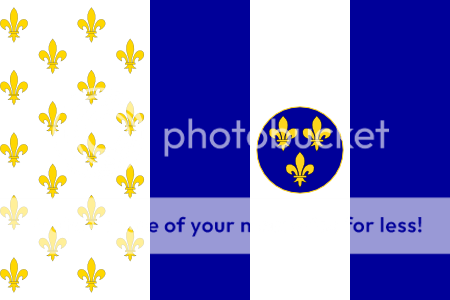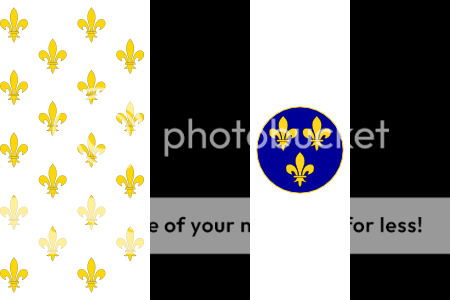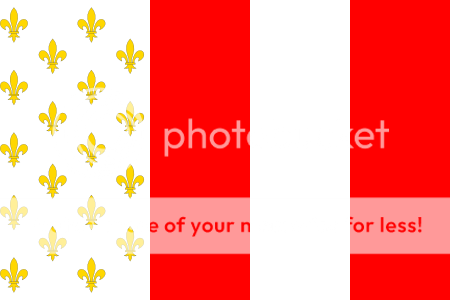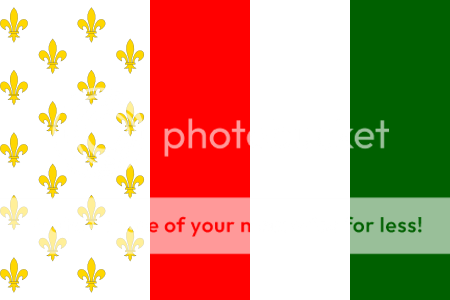Here are the entries submitted to Round 78 of the WFC. Please vote.
1 said:Following the Treaty of Utrecht, the French royal government reorganises its colonial holdings, and institutes flags which clearly identify both the Viceroyalty and Province of the bearer. The design is simple: the hoist third is the lilies on white of the Royal government, while the fly two thirds shows the regimental banner of the colony in question. Viceroyalties additionally bear the arms of the House of Bourbon on the regimental colour.
The Regimental flags are structured to show allegiance. The hoist colour represents the Viceroyalty, while the fly colour is unique to the Province within the Viceroyalty. The capital Province will always have matching fly and hoist.
Examples of Viceregal flags:
Vice-royauté de Nouvelle-France (New France):

Vice-royauté des Antilles (Caribbean):

Examples of provincial flags :
Province des Indes orientales du Sud (South India):

Province des Indes orientales du Nord (North India):

2 said:The Swedish keep Wismar and coastal Ingria, don't loose the Gold Coast to the Danish, make gains in the Caribbean, buy the Sulu archipelago and parts of Mindanao and Borneo, and gain Moheli after World War II. During the 1950s, they reform their colonies, including the flags. They introduce a simple, secular flag with a Swedish blue background and a yellow strip, rather than a cross, going through the hoist, and a strip of a color representing the colony on the opposite side of the flag.
The population of each colony voted for the colony's color in 1952. Wismar chose a light gray to represent the fish on their coat of arms. Ingria chose red, so that red, yellow and blue, the three colors of the Ingrian flag, would be visible on the Swedish Ingria's flag. The Gold Coast chose black, inspired by neighboring Ghana's "black stars". The Swedish West Indies chose green, for the many forests that existed on the three islands of the Swedish West Indies. The Swedish East Indies chose an eggplant color, the same as the one on the former Sulu Sultanate. Finally, Moheli chose the gold on the Mohelian island's flag.

3 said:Dania
By 1000 the Danish Kingdoms of Gothenland, Scaneland, Sealand, and Jutland, had been unified and redivided enough times that Haricnut's accession to each crown was not considered unique; his expansion to include the Danish colony-kingdoms of Vickenland, Yorwick, and the Norwegian lands, was also considered a one off and it was expected his empire would die with him. Unusually however this empire was passed down intact to Erik I (regnal numbering traditionally starts here) also known as Happy Axe for his boistrous personal executions of his enemies. Though in his later years the Norwegian Kingdoms, Vickenland, and Yorwick were lost, Erik passed on the union known as Dania or Danerike and tradition holds that the first known banner consisted of a crown surrounded by 4 sealeaves...
..folkore recounts that King Harald III sorely beset at Rygen implored God for a sign to continue battle and down from the sky drifted the Dannebrog formed from the tatters of the old Royal Banner smeared with bloody cross. Taking this as his new standard Harald fought on, maintained his throne, and added the West Wendish March to his Kingdom.
Flag of the Danian Colonies
The Colonial Flags of Dania are based upon that of former Danian Mariana.
In order to signify Danian possession the local Prince Governor added the Danian flag to the hoist of the Marianan Standard.
On ascending the throne following his brother's death, Erik VI continued with this them for his colonial possessions.

4 said:The Kingdom of the Netherlands, inspired by the British example, reforms it's colonial empire in the late 1890s and adopts a colonial ensign, the Oranje Koloniaal (first flag).

The Oranje Koloniaal became the basis for the various colonies, including Surinam (second flag) and the colonies which were created in the East Indies Division in 1896, e.g. Sumatra (third flag). The simple emblem of Suriname stood for the natural wealth of the colony (green diamond) and the union between the five ethnicities (five-pointed star). The more complex emblem of Sumatra, typical for the East Indies colonies, stood for the complex and rich history of the island (the "frame"), the peace between Islam and Hinduism (red-white-green) and the cotton stood for industrial progress.


5 said:I give you Colonial Scotland. As a result of Charles II of Spain dying within days of the the landing of the Darien Venture colonists, the War of the Spanish Succession starts earlier. Scotland remains neutral, and retains its independence and its Darien colony. In the late 18th Century, Scottish settlement of Nova Scotia (OTL Vancouver Island) begins, and in the early 19th Century, Scotland manages to acquire the Sandalwood Islands (OTL Eastern Bismarck Archipelago and Western Solomons) and the island of Pemba, as well as some other colonies, but the others were lost before Scotland become a republic in the early 20th Century. These are the last flags in use by each colony before their respective admissions as constituent provinces of the Republic of Scotland.

6 said:A small sampling of the colonial ensigns of the Italian Empire as per the 1927 template. Though technicaly not colonies, flag chosen by the government for the protectorates do tend to somewhat follow the colonial pattern altough with the royal crown instead of the colonial one.

7 said:
The Kingdom of Bética was founded following the repulsing of the Franks (1224). In the following 2 centuries the Béticans were in the forefront of the expelling of the French to north of the Pyrenees.
In 1411 Bética and England formed their first official alliance to face France, the common enemy.
During the turbulent times of the Reformation, Bética and England were the main champions of the Catholic cause, partly the reason for Pope Boniface X issuing a Papal Bull (1493) ‘dividing the New World’ between those nations (south of Hispaniola to Spain, all to the north to England)
The Kingdom of Great Bética was created in 1610 following the conquest of Portugal.
The prolonged war between Catholics and Asseverants in the Italian States and the assassination of 4 Popes within a year saw the flight (1615) of Pope Adrian VII to Bética, where King Juan XIII made a grant of land in and around the city of Madrid to the Holy See. This was later (1789) given the status of an independent nation, the Papal State.
The joint intervention of Catholic Bética and England and Asseverant Austria and France led to the creation of 2 Italian states (1632), an Asseverant Republic to the north and a Catholic Kingdom to the South, with each of the interventionist nations annexing territory (Bética taking the island of Sardinia).
King Juan XIV died (1703) leaving just one daughter, Ana Luisa, who was married to the second son (Richard Edward) of Richard VII of England. In 1706 the couple became joint monarchs, creating the royal house of Plantagenet y Guzmán.
During the 19th Century, colonies in Africa, Australisia and the Pacific were added to the Bétican Empire. In 1870 a formal code for flags for the colonies was introduced, a standard format to which was added one or more devices (usually fauna or flora related).
The colony of Ricardia, on the west coast of the main island of Australisia, was created in 1828. Its flag bears the marsupial (Kangaroo), a local weapon (Boomerang) and a Nativity Star (the first landing of Béticans having taken place on 25 December 1728).
Flag of Great Bética

Colonies 'template'

Flag of the colony of Ricardia

8 said:The history of Courish overseas colonies is one of sheer dumb luck, cunning diplomacy and clever trade tricks. Bolstering Courish colonial know-how by learning from the experiences of the already up-and-running Swedish and Danish colonial empires only added to the favourable constellation. And having Peter the Great die at a young age while touring the world - not opening the proverbial window into Europe for Russia and its nigh-existent navy - didn't hurt either...

Template for the flags of the colonies within Courland's colonial empire

Colonial flag of New Courland

Colonial flag of Saint Andrew's Island and Courish Gambia
Symbolism:
The left field of all Courish colonial flags bears the small coat of arms of the Duchy of Courland and Semigallia. The field is coloured gules.
The colony of New Courland lies on an island that the Spaniards (but also the British) traditionally call Tobago. When the weary but eager Courish colonists first set foot on the island's soil, they were bewildered by this tropical paradise, so unlike the windy, cold shores of their Baltic homeland... Even though they soon learned that the island isn't a garden of Eden made real, their fondness for the wonders of their new home and workplace still permeated a lot of their early domestic arts and insignia. Most bewildiring of all were the large, meaty crabs crawling on the island's beaches. The colonists were familiar with small Baltic crab species, but these large, odd creatures with even larger claws were like nothing they've seen before. As the months passed and the idea of making a flag for this Courish overseas fief was brought up, someone jokingly suggested that they could put a crab on the flag. "They are really tasty when you cook'em well, taste almost like chicken, yum - they should be honoured...". What was at first a joke soon became a real, approved choice. An or crab with thick legs, proudly spread claws and comical little eyes appeared on a gules field. A year later, they also added an or sailing ship to the flag, in order to always remind them of where they came from and of the colony's economic reliance on regular sea trade. Once Courland secured its holdings in the eastern half of the island and chased the British and Spanish out via help from the French, nothing stood in their plans for small but profitable sugar cane plantations. While always low on slaves as well as any free manpower, sugar brought both New Courland and Old Courland some pretty hefty profits - and so, vert and or sugar canes now adorned the final version of the colonial flag, as a reminder of where the colony's boost in wealth came from...
The stylized argent colonial star fort represents the real star fort and its accompanying colonial settlement on Saint Andrew's Island in the estuary of the river Gambia. The four flowing argent waves represent both the river Gambia itself and the Atlantic Ocean - two great bodies of water between which the island lies. The isle and its fort were the first great Courish foothold in Africa. They served as a stepping stone for the further expansion along the Gambian coastline and the river Gambia's shores that came later, as Courish interests in the area intensified and the trade with ivory, sugar and gold grew. Mainland Courish Gambia reached its maximum historical extent at roughly 80 miles into the African interior, mostly along the Gambia. The last territorial extension inland occured in the 1730s. Little has changed since then.
The flags you see here are the final, definite versions, created during the standardization of Courland's state and colonial symbols in the mid 1870s. The standardization included the changing of the colour of all the colony-specific fields to azure.
Last edited: